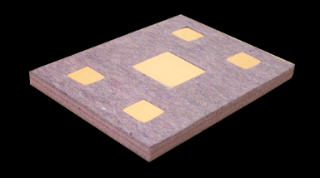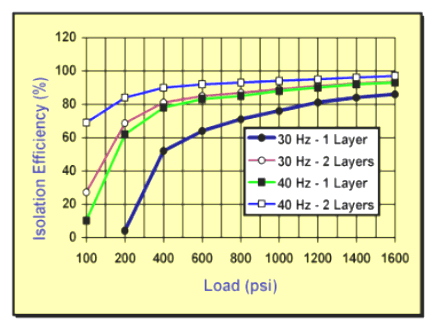COMBINATION
PRESS PADS |
 As
a press blow is struck, the entire press frame including its foundation
is set into motion. This motion is essentially a free oscillation.
Extremely high loads can be introduced into the internal press
frame components and foundation area. As
a press blow is struck, the entire press frame including its foundation
is set into motion. This motion is essentially a free oscillation.
Extremely high loads can be introduced into the internal press
frame components and foundation area.
The Combination Press Pad sharply reduces these forces
through the energy absorption. Due to a high coefficient of damping,
it quickly dampens out this free oscillation and limits the number
of shock pulses being transmitted. This also ensures that the
press frame and foundation will be completely at rest before the
next blow is struck.
|
 Click
here for Combination Press Pads Technical Data Sheet - PDF Format Click
here for Combination Press Pads Technical Data Sheet - PDF Format |
BASIC
CONFIGURATION
UNISORB Titan Shock Pads are inserted into the Red-Line material
which acts as a frame for secondary support. Full contact is obtained
with sizes matching each press foot. By varying the size and number
of inserts, it ensures that the combination pads are working within
optimum load ranges. This interdependent system allows the pads
to be fine-tuned to the individual support requirements of the press.
PERFORMANCE AND OPTIMUM LOADS
The optimum load range for the Combination Press Pad Combination
Pads with Titan Shock Pad inserts is between 800 and 1000 psi. This
places the material in a favorable compressive work range for maximum
pad life. Calculations are made to determine the approximate configuration
for each pad set.
The performance of a press is greatly affected by how it is installed.
Without proper support, a multitude of problems can
occur from unwanted vibrations to premature wear of press components
and tooling. Due to the higher cost of mounts, pad materials are
often used where critical levelling and alignment is not required.
Problems can occur however, when the combined weight/force of the
press exceeds the capacity of these conventional materials. Careful
selection is necessary to ensure that the pad accommodates the difference
between the static and dynamic forces and other factors such as
off-load conditions.
|
Combination
Press Pads are now available to
meet the specific requirements of
each press applications.
|
 |
Most
presses
exhibit an interfering frequency in the 30 to 50 Hz range. This graph
shows the attainable isolation values (30 and 40 Hz plotted) based
on the deflection characteristics of the combination pads with the
Titan inserts. Further isolation can be achieved by increasing the
deflection with additional layers of the pads.
|
COMBINED PERFORMANCE
UNISORB Red-Line Anchor Pads have been used to isolate presses for
over 50 years, and provide excellent vibration control and damping.
UNISORB Titan Shock Pads also provide excellent damping, especially
under extreme loads and high shock applications. When used together,
these well engineered pad materials reach a level of performance
unattainable with stand alone products. The Combination Press Pad
offers static support, frictional contact and the capacity to handle
impact forces with a wide safety margin.
|
|








 As
a press blow is struck, the entire press frame including its foundation
is set into motion. This motion is essentially a free oscillation.
Extremely high loads can be introduced into the internal press
frame components and foundation area.
As
a press blow is struck, the entire press frame including its foundation
is set into motion. This motion is essentially a free oscillation.
Extremely high loads can be introduced into the internal press
frame components and foundation area.